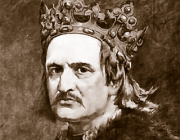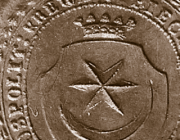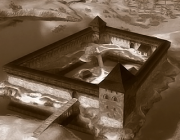Architecture and history of the Kreva Castle
Today only ruins remained from the Kreva Castle, but what did the castle look like?
Kreva castle has reached our days in a quite shabby condition. But they haven’t built it for fascination and admiration. First of all it was a defensive structure.
When did the Kreva Castle appear?
There is no exact information about this. Documents which could to identify the exact date of the castle construction are not preserved.
It is commonly believed that the castle appeared between the second half of the XIII and the end of the XIV centuries. In the 1960s, the Kreva Castle was studied by the Lithuanian architect Stasys Abramavskas. He came to the conclusion that the building belongs to the XIII century. Some technical features that are typical for the architecture of the Baltic region in those period prove his theory.
Who built Kreva Castle?
Scientists have several versions. The “Chronicle of Litva and Zhamoicj” tells how Prince Gedimin shared his lands among his sons. And to one of them, Olgerd, was granted with “The Kreva Castle”. But this source is not a very reliable one. Lithuanian chronicles were written not in the time of events but much later, so this description could be inaccurate.
“The Kreva Castle” can be found in many annals, but it is not specified, is it a stone or a wooden castle located on the hill fort. Modern scientists believe that the stone castle was built on order of Olgerd after the year of 1338. But there are no direct evidences of this theory either.
For the first time The Kreva Castle built from stone was mentioned in the “List of far and near Russian cities”, the document from the end of the XIV – the beginning of the XV centuries. With the other Lithuanian cities “The Krev Stone” is mentioned in it, and this message does not contradict the arguments of those who attribute the castle to the times of Olgerd.
There is no doubt about it the all the further important events took place in this castle, which ruins have survived till our days – the killing of Keistut, the capture and escape of Vitovt, the signing of the Unia of Kreva.
What was the Kreva Castle looked like?
The Kreva Castle stands in a valley, surrounded by high hills, where the river Krevlianka merges with the creek. Why did the ancient architects choose for the construction a swampy lowland instead of high hill? Perhaps the weaponry at those times were not powerful enough, so they considered that the swamp could be an additional barrier to potential invaders.
On Plane the walls of the castle resembled an incorrect trapezoid with two towers situated on diagonal corners. The bigger one in the north-west corner of the castle was the tower of Prince, it stood outside the perimeter of the walls. The tower was placed outside for a reason: in case of assault it was possible to defence walls of the castle on north and west at the same time.
The tower of Prince was at least three levels high. There was a prison in the dungeon, the prince’s rooms were on the second floor. The windows there were wider and higher and the walls were painted with ornaments. The second tower was smaller. Most likely it was built later than the first one.
The walls of the castle were built of stone and faced with bricks outside. The entrance to the castle was on the northern side. There were residential and outbuildings in the courtyard. In the western part was a pond with water and from one tower to the other led a paved road. The castle had an impressive area – during the enemy raids not only the soldiers but also the civilians could find shelter behind the stone walls.
The castle was a witness of many historical events, but the most important of them was the signing of the Unia of Kreva in 1385, an agreement between the Grand Duchy of Lithuania and Poland.
The Kreva Castle also learned the bitterness of destruction. During the First World War the castle was heavy demolished. In the period between two wars the government of Poland, which at that time included Kreva, allocated funds for preservation of the historical building. Restoration works on ruins of the castle are held also in our days.







